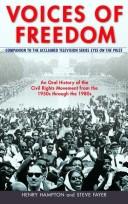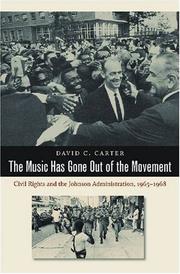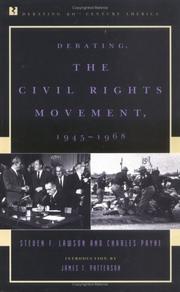| Listing 1 - 10 of 16 | << page >> |
Sort by
|

ISBN: 1282060031 9786612060038 1433390744 9781433390746 Year: 2008 Publisher: Huntington Beach, CA Teacher Created Materials
Abstract | Keywords | Export | Availability | Bookmark
 Loading...
Loading...Choose an application
- Reference Manager
- EndNote
- RefWorks (Direct export to RefWorks)
Although slavery was illegal at the beginning of the twentieth century, segregation was prevalent, especially in the South. Through many uprisings, protests, and demonstrations, segregation was finally abolished and civil rights were established for people of varying colors, races, and genders. Today, we celebrate diversity in our nation because of the Civil Rights Movement of the twentieth century.
Book
ISBN: 9780197507780 0197507778 9780197507773 0197507786 0197507808 Year: 2021 Publisher: Oxford Oxford University Press
Abstract | Keywords | Export | Availability | Bookmark
 Loading...
Loading...Choose an application
- Reference Manager
- EndNote
- RefWorks (Direct export to RefWorks)
"The Movement for Black Lives (MBL) has gained worldwide visibility as a grassroots social justice movement distinguished by a decentralized, non-hierarchal mode of organization. MBL rose to prominence in part thanks to its protests against police brutality and misconduct directed at black Americans. However, its animating concerns are far broader, calling for a wide range of economic, political, legal, and cultural measures to address what it terms a "war against Black people," as well as the "shared struggle with all oppressed people." Despite the significance of the social, political, and economic goals of MBL, as well as the innovative organizational leadership strategies it employs, MBL has received little sustained philosophical attention. The Movement for Black Lives: Philosophical Perspectives brings philosophical analysis to bear on the aims, strategies, policy positions, and intellectual-historical context of MBL. Leading scholars address the following themes: "Black Lives Matter" as a political speech act, MBL's conception of the value of black lives, the gender dynamics of the Movement, the relation of MBL to other black liberation movements and transitional justice movements, the Movement's new forms of leadership and organization, and the impact of racism on the normative assessment of the criminal justice system. Accordingly, the volume broaches a wide range of pressing issues in the philosophy of language, social and political philosophy, philosophy of race, philosophy of gender, and the philosophy of punishment. It is important reading for students and scholars in the humanities and social sciences interested in race, inequality, and social justice movements"--
Book
ISSN: 19627505 ISBN: 9782713228124 2713228123 Year: 2020 Volume: 92 Publisher: Paris Éditions de l'École des hautes études en sciences sociales
Abstract | Keywords | Export | Availability | Bookmark
 Loading...
Loading...Choose an application
- Reference Manager
- EndNote
- RefWorks (Direct export to RefWorks)
Le corps noir étant la cible première de l’oppression raciste, les Africains-Américains ont fait du corps sportif une dimension essentielle, bien que souvent négligée, de leur résistance politique. Nicolas Martin-Breteau propose une histoire renouvelée de la manière dont le sport noir américain, depuis la fin du XIXe siècle, a participé aux longues luttes pour la dignité et la justice raciales aux États-Unis. À la fin du XIXe siècle, la violence raciste dirigée contre la communauté africaine-américaine a détruit les avancées historiques obtenues par l’abolition de l’esclavage une génération plus tôt. Nicolas Martin-Breteau retrace ici la manière dont les Africains-Américains ont utilisé le sport pour leur intégration dans la société américaine. L’éducation physique s’est ainsi faite éducation politique afin de renforcer la fierté raciale à l’intérieur du groupe puis démanteler les préjugés raciaux à l’extérieur. Corps politiques montre comment Washington a constitué le berceau méconnu de ce programme d’élévation individuelle et de libération collective qui continue d’influencer les mobilisations antiracistes noires aux États-Unis.
Book
ISBN: 9780415826129 9780415826143 9780203431863 9781135980689 9781135980757 0415826144 0203431863 0415826128 Year: 2016 Publisher: New York London Routledge
Abstract | Keywords | Export | Availability | Bookmark
 Loading...
Loading...Choose an application
- Reference Manager
- EndNote
- RefWorks (Direct export to RefWorks)
African Americans --- Civil rights movements --- Black power --- Civil rights --- History --- 20th century --- United States --- African Americans - Civil rights - History - 20th century --- Civil rights movements - United States - History - 20th century --- Black power - United States - History - 20th century
Book
ISBN: 067441649X 9780674416499 9780674050297 0674050290 Year: 2014 Publisher: Cambridge, MA
Abstract | Keywords | Export | Availability | Bookmark
 Loading...
Loading...Choose an application
- Reference Manager
- EndNote
- RefWorks (Direct export to RefWorks)
The Civil Rights Revolution carries Bruce Ackerman's sweeping reinterpretation of constitutional history into the era beginning with Brown v. Board of Education. From Rosa Parks's courageous defiance, to Martin Luther King's resounding cadences in "I Have a Dream," to Lyndon Johnson's leadership of Congress, to the Supreme Court's decisions redefining the meaning of equality, the movement to end racial discrimination decisively changed our understanding of the Constitution. Ackerman anchors his discussion in the landmark statutes of the 1960's: the Civil Rights Act of 1964, the Voting Rights Act of 1965, and the Fair Housing Act of 1968. Challenging conventional legal analysis and arguing instead that constitutional politics won the day, he describes the complex interactions among branches of government--and also between government and the ordinary people who participated in the struggle. He showcases leaders such as Everett Dirksen, Hubert Humphrey, and Richard Nixon who insisted on real change, not just formal equality, for blacks and other minorities. The civil rights revolution transformed the Constitution, but not through judicial activism or Article V amendments. The breakthrough was the passage of laws that ended the institutionalized humiliations of Jim Crow and ensured equal rights at work, in schools, and in the voting booth. This legislation gained congressional approval only because of the mobilized support of the American people--and their principles deserve a central place in the nation's history. Ackerman's arguments are especially important at a time when the Roberts Court is actively undermining major achievements of America's Second Reconstruction.
Constitutional history --- Constitutional law --- Civil rights movements --- Civil liberation movements --- Liberation movements (Civil rights) --- Protest movements (Civil rights) --- Human rights movements --- History. --- Constitutional history-United States. --- Constitutional law-United States. --- Civil rights movements-United States-History.
Book
ISBN: 0674065301 0674069560 9780674069565 9780674065307 9780674046870 0674046870 Year: 2012 Publisher: Cambridge, MA
Abstract | Keywords | Export | Availability | Bookmark
 Loading...
Loading...Choose an application
- Reference Manager
- EndNote
- RefWorks (Direct export to RefWorks)
Representing the Race tells the story of an enduring paradox of American race relations, through the prism of a collective biography of African American lawyers who worked in the era of segregation. Practicing the law and seeking justice for diverse clients, they confronted a tension between their racial identity as black men and women and their professional identity as lawyers. Both blacks and whites demanded that these attorneys stand apart from their racial community as members of the legal fraternity. Yet, at the same time, they were expected to be "authentic"-that is, in sympathy with the black masses. This conundrum, as Kenneth W. Mack shows, continues to reverberate through American politics today.Mack reorients what we thought we knew about famous figures such as Thurgood Marshall, who rose to prominence by convincing local blacks and prominent whites that he was-as nearly as possible-one of them. But he also introduces a little-known cast of characters to the American racial narrative. These include Loren Miller, the biracial Los Angeles lawyer who, after learning in college that he was black, became a Marxist critic of his fellow black attorneys and ultimately a leading civil rights advocate; and Pauli Murray, a black woman who seemed neither black nor white, neither man nor woman, who helped invent sex discrimination as a category of law. The stories of these lawyers pose the unsettling question: what, ultimately, does it mean to "represent" a minority group in the give-and-take of American law and politics?
African American lawyers --- Cause lawyers --- Civil rights movements --- Cause lawyering --- Lawyers --- Public interest law --- History --- Civil rights lawyers --- African American lawyers - Biography --- Civil rights lawyers - United States - Biography --- Civil rights movements - United States - History - 20th century --- Etats-Unis

ISBN: 0553057340 Year: 1990 Publisher: New York London Auckland Bantam Books
Abstract | Keywords | Export | Availability | Bookmark
 Loading...
Loading...Choose an application
- Reference Manager
- EndNote
- RefWorks (Direct export to RefWorks)
Oral history --- Afro-Americans - Civil rights - History - 20th century - Sources. --- Civil rights movements - United States - History - 20th century. --- United States - Race relations - Sources. --- Afro-Americans - History - 1877-1964 - Sources. --- Afro-Americans - History - 1964- - Sources. --- Oral history.

ISBN: 1469606577 0807832804 1469622009 9781469606576 9780807832806 9798890879615 Year: 2009 Publisher: Chapel Hill
Abstract | Keywords | Export | Availability | Bookmark
 Loading...
Loading...Choose an application
- Reference Manager
- EndNote
- RefWorks (Direct export to RefWorks)
After the passage of sweeping civil rights and voting rights legislation in 1964 and 1965, the civil rights movement stood poised to build on considerable momentum. In a famous speech at Howard University in 1965, President Lyndon B. Johnson declared that victory in the next battle for civil rights would be measured in ""equal results"" rather than equal rights and opportunities. It seemed that for a brief moment the White House and champions of racial equality shared the same objectives and priorities. Finding common ground proved elusive, however, in a climate of growing social and political
African Americans - Civil rights - History - 20th century. --- African Americans -- Civil rights -- History -- 20th century. --- Civil rights movements - United States - History - 20th century. --- Civil rights movements -- United States -- History -- 20th century. --- United States - Politics and government - 1963-1969. --- United States -- Politics and government -- 1963-1969. --- African Americans --- Civil rights movements --- Gender & Ethnic Studies --- Social Sciences --- Ethnic & Race Studies --- History --- Civil rights --- Afro-Americans --- Black Americans --- Colored people (United States) --- Negroes --- Civil liberation movements --- Liberation movements (Civil rights) --- Protest movements (Civil rights) --- Africans --- Ethnology --- Blacks --- Human rights movements --- Black people --- United States --- Politics and government
Book
ISBN: 0813588537 0813588545 9780813588544 9780813588537 9780813588537 9780813588520 0813588529 9780813588513 0813588510 Year: 2017 Publisher: New Brunswick, NJ
Abstract | Keywords | Export | Availability | Bookmark
 Loading...
Loading...Choose an application
- Reference Manager
- EndNote
- RefWorks (Direct export to RefWorks)
Black Movements analyzes how artists and activists of recent decades reference earlier freedom movements in order to imagine and produce a more expansive and inclusive democracy. The post-Jim Crow, post-apartheid, postcolonial era has ushered in a purportedly color blind society and along with it an assault on race-based forms of knowledge production and coalition formation. Soyica Diggs Colbert argues that in the late twentieth century race went "underground," and by the twenty-first century race no longer functioned as an explicit marker of second-class citizenship. The subterranean nature of race manifests itself in discussions of the Trayvon Martin shooting that focus on his hoodie, an object of clothing that anyone can choose to wear, rather than focusing on structural racism; in discussions of the epidemic proportions of incarcerated black and brown people that highlight the individual's poor decision making rather than the criminalization of blackness; in evaluations of black independence struggles in the Caribbean and Africa that allege these movements have accomplished little more than creating a black ruling class that mirrors the politics of its former white counterpart. Black Movements intervenes in these discussions by highlighting the ways in which artists draw from the past to create coherence about blackness in present and future worlds. Through an exploration of the way that black movements create circuits connecting people across space and time, Black Movements offers important interventions into performance, literary, diaspora, and African American studies.
African American theater --- Performing arts --- African Americans --- Show business --- Arts --- Performance art --- Afro-American theater --- Theater, African American --- Theater --- History. --- Civil rights --- Civil rights movements --- African Americans in the performing arts --- History --- African American theater - History --- Performing arts - United States - History --- African Americans - Civil rights - History --- Civil rights movements - United States - History --- Civil rights movements - History

ISBN: 0847690539 0847690547 9780847690534 Year: 1998 Publisher: Lanham, Md. : Rowman & Littlefield,
Abstract | Keywords | Export | Availability | Bookmark
 Loading...
Loading...Choose an application
- Reference Manager
- EndNote
- RefWorks (Direct export to RefWorks)
African Americans --- Civil rights movements --- Noirs américains --- Ligues des droits de l'homme --- Civil rights --- Historiography --- History --- Sources --- Historiography. --- Sources. --- Droits --- Historiographie --- Histoire --- United States --- Etats-Unis --- Race relations --- Relations raciales --- African Americans - Civil rights - History - 20th century - Sources --- African Americans - Civil rights - Historiography --- Civil rights movements - United States - History - 20th century - Sources --- Civil rights movements - United States - Historiography --- United States - Race relations - Sources --- United States - Race relations - Historiography
| Listing 1 - 10 of 16 | << page >> |
Sort by
|

 Search
Search Feedback
Feedback About UniCat
About UniCat  Help
Help News
News